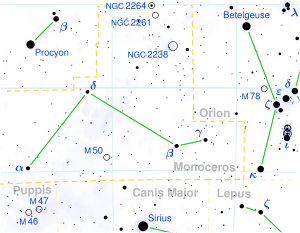3 Monocerotis
| Observation data Epoch J2000 Equinox J2000 | |
|---|---|
| Constellation | Monoceros |
| Right ascension | 06h 01m 50.42241s[1] |
| Declination | −10° 35′ 52.5565″[1] |
| Apparent magnitude (V) | 4.92[2] |
| Characteristics | |
| Spectral type | B5III[3] |
| U−B color index | -0.58[4] |
| B−V color index | -0.12[4] |
| Astrometry | |
| Radial velocity (Rv) | +39.00[5] km/s |
| Proper motion (μ) | RA: -5.89[1] mas/yr Dec.: +2.94[1] mas/yr |
| Parallax (π) | 4.16 ± 0.55[1] mas |
| Distance | approx. 800 ly (approx. 240 pc) |
| Absolute magnitude (MV) | -1.94[2] |
| Details | |
| Mass | 5.85[6] M☉ |
| Luminosity | 1105[2] L☉ |
| Temperature | 15,000[6] K |
| Metallicity [Fe/H] | 0.00[7] dex |
| Rotational velocity (v sin i) | 45[8] km/s |
| Other designations | |
| Database references | |
| SIMBAD | data |
3 Monocerotis is a class B5III[3] (blue giant) star in the constellation Monoceros. Its apparent magnitude is 4.92[2] and it is approximately 780 light years away based on parallax.[1]
In addition to the primary, which is itself a spectroscopic binary, there is one companion, B, with magnitude 7.96 and separation 1.9".[9]
References
- 1 2 3 4 5 6 Van Leeuwen, F. (2007). "Validation of the new Hipparcos reduction". Astronomy and Astrophysics. 474 (2): 653. arXiv:0708.1752
 . Bibcode:2007A&A...474..653V. doi:10.1051/0004-6361:20078357. Vizier catalog entry
. Bibcode:2007A&A...474..653V. doi:10.1051/0004-6361:20078357. Vizier catalog entry - 1 2 3 4 Anderson, E.; Francis, Ch. (2012). "XHIP: An extended hipparcos compilation". Astronomy Letters. 38 (5): 331. arXiv:1108.4971
 . Bibcode:2012AstL...38..331A. doi:10.1134/S1063773712050015. Vizier catalog entry
. Bibcode:2012AstL...38..331A. doi:10.1134/S1063773712050015. Vizier catalog entry - 1 2 Hoffleit, D.; Warren, W. H. (1995). "VizieR Online Data Catalog: Bright Star Catalogue, 5th Revised Ed. (Hoffleit+, 1991)". VizieR On-line Data Catalog: V/50. Originally published in: 1964BS....C......0H. 5050. Bibcode:1995yCat.5050....0H.
- 1 2 Mallama, A. (2014). "Sloan Magnitudes for the Brightest Stars". The Journal of the American Association of Variable Star Observers. 42: 443. Bibcode:2014JAVSO..42..443M.Vizier catalog entry
- ↑ Gontcharov, G. A. (2006). "Pulkovo Compilation of Radial Velocities for 35 495 Hipparcos stars in a common system". Astronomy Letters. 32 (11): 759. Bibcode:2006AstL...32..759G. doi:10.1134/S1063773706110065.
- 1 2 Hohle, M.M.; Neuhäuser, R.; Schutz, B.F. (2010). "Masses and luminosities of O- and B-type stars and red supergiants". Astronomische Nachrichten. 331 (4): 349. arXiv:1003.2335
 . Bibcode:2010AN....331..349H. doi:10.1002/asna.200911355. Vizier catalog entry
. Bibcode:2010AN....331..349H. doi:10.1002/asna.200911355. Vizier catalog entry - ↑ Gontcharov, G. A. (2012). "Dependence of kinematics on the age of stars in the solar neighborhood". Astronomy Letters. 38 (12): 771. arXiv:1606.08814
 . Bibcode:2012AstL...38..771G. doi:10.1134/S1063773712120031. Vizier catalog entry
. Bibcode:2012AstL...38..771G. doi:10.1134/S1063773712120031. Vizier catalog entry - ↑ Abt, Helmut A.; Levato, Hugo; Grosso, Monica (2002). "Rotational Velocities of B Stars". The Astrophysical Journal. 573: 359. Bibcode:2002ApJ...573..359A. doi:10.1086/340590.
- ↑ Mason, Brian D.; Wycoff, Gary L.; Hartkopf, William I.; Douglass, Geoffrey G.; Worley, Charles E. (2001). "The 2001 US Naval Observatory Double Star CD-ROM. I. The Washington Double Star Catalog". The Astronomical Journal. 122 (6): 3466. Bibcode:2001AJ....122.3466M. doi:10.1086/323920. Vizier catalog entry
This article is issued from Wikipedia - version of the 11/27/2016. The text is available under the Creative Commons Attribution/Share Alike but additional terms may apply for the media files.
